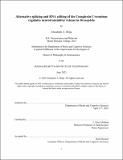Alternative splicing and RNA editing of the Complexin C-terminus regulates neurotransmitter release in Drosophila
Author(s)
Brija, Elizabeth A.
DownloadThesis PDF (6.239Mb)
Advisor
Littleton, J. Troy
Terms of use
Metadata
Show full item recordAbstract
Chemical synaptic transmission is an essential and highly regulated step in neuronal communication. Changes in the strength of synaptic transmission mediate several forms of plasticity associated with learning and memory. Functional regulation of Complexin (Cpx) provides an entry point for altering presynaptic output since the protein controls spontaneous and evoked neurotransmitter release through its effects on SNARE complex assembly. The Drosophila cpx locus undergoes alternative splicing to produce two isoforms (Cpx7A and Cpx7B) that differ in the C-terminal ~20 amino acids of Cpx. Although PKA phosphorylation of Cpx7B C-terminal residue S126 enhances spontaneous release and synaptic growth in Drosophila, the more abundant Cpx7A does not undergo PKA phosphorylation, but is subject to RNA editing that produces three alternative C-terminal domain residues (N130S, N130D, N130G). Edit variant N130S contains a phospho-competent residue located in a similar C-terminal region to the Cpx7B PKA phosphorylation site, but the functional significance of Cpx7A RNA editing in regulating neurotransmission and structural plasticity is unknown.
In this thesis, I characterized the role of alternative splicing and RNA editing in Cpx function. I found that Cpx7A and Cpx7B splice isoforms have largely redundant roles in regulating neurotransmitter release despite significant expression level differences. Single-cell RNAseq data revealed multiple Cpx7A RNA editing variants are co-expressed, indicating editing acts stochastically to generate a range of edited Cpx proteins within individual cells. To determine if RNA editing alters Cpx7A function, I compared synaptic transmission and growth properties in cpx null mutants rescued with unedited or edited Cpx7A transgenes. N130S variants displayed a dramatic reduction in spontaneous fusion clamping compared to unedited Cpx7A. In addition, N130S can dominantly function when co-expressed with unedited Cpx7A, suggesting the abundance of edited proteins within single neurons can fine-tune their baseline neurotransmission. N130S displayed altered subcellular localization, suggesting altered ability of the edited protein to tether to synaptic vesicles. Additionally, casein kinase 2 was found to phosphorylate the N130S variant. Together, these findings indicate Cpx7A and Cpx7B have redundant roles in controlling baseline neurotransmission, while differential RNA editing of Cpx7A alters Cpx’s clamping properties and functionally changes presynaptic output by enhancing spontaneous neurotransmitter release.
Date issued
2023-06Department
Massachusetts Institute of Technology. Department of Brain and Cognitive SciencesPublisher
Massachusetts Institute of Technology